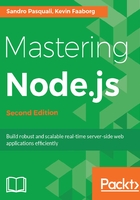
Understanding Asynchronous Event-Driven Programming
"The best way to predict the future is to invent it."
– Alan Kay
Eliminating blocking processes through the use of event-driven, asynchronous I/O is Node's primary organizational principle. We've learned how this design helps developers in shaping information and adding capacity. Node lets you build and organize lightweight, independent, and share-nothing processes that communicate through callbacks and synchronize with a predictable event loop.
Accompanying the growth in the popularity of Node is a growth in the number of well-designed event-driven systems and applications. For a new technology to be successful, it must eliminate the existing problems, and/or offer to consumers a better solution at a lower cost in terms of time, effort, or price. In its young and fertile lifespan, the Node community has collaboratively proven that this new development model is a viable alternative to the existing technologies. The number and quality of Node-based solutions powering enterprise-level applications provides further proof that these new ideas are not only novel, but preferred.
In this chapter, we will delve deeper into how Node implements event-driven programming. We will begin by unpacking the ideas and theories that event-driven languages and environments derive from and grapple with, in an effort to clear away misconceptions and encourage mastery. Following this introduction to events, we'll look at the key Node.js technology—the event loop. We'll then go into more detail on how Node implements timers, callbacks, and I/O events, and how you as a Node developer can use them. We'll further discuss management of concurrency using modern tools such as Promises, Generators, and async/await. We'll practice the theory as we build up some simple but exemplary file and data-driven applications. These examples highlight Node's strengths, and show how Node is succeeding in its ambition to simplify network application designs.